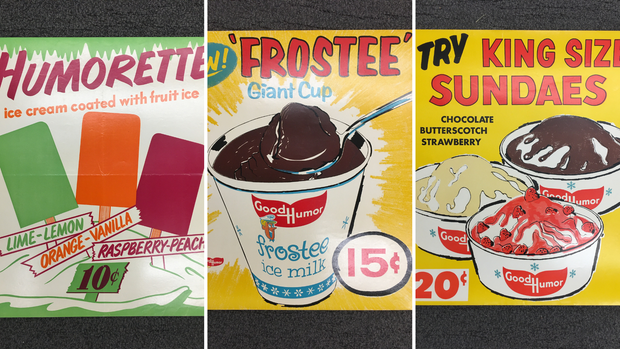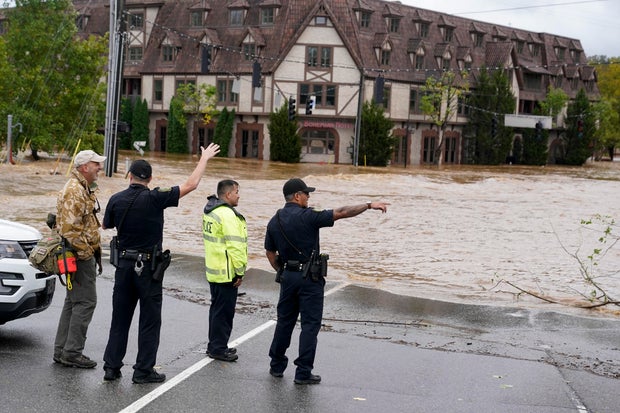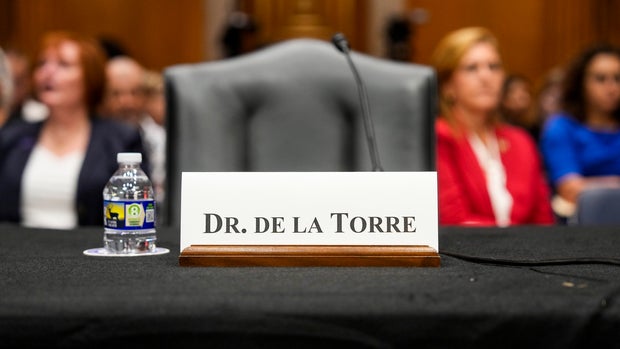CBS News
Where did the ice cream truck come from? How the summer staple came to be.

Excited children run through parks and race down blocks to get cones, bars and soft serve on sweltering summer days as the sound of the iconic jingle gets louder and the ice cream truck nears.
While frozen sweet treats have been around in some form or other for thousands of years, inventions over the years have brought ice cream to the people. One innovation, the ice cream truck, has been luring children and adults alike to the street for a century. The trucks are now a staple part of summer in the U.S.
“Ice cream trucks changed the way people viewed ice cream as they created a new level of accessibility that didn’t exist before,” said Manish Vora, co-founder and co-CEO of Museum of Ice Cream, which started as a pop-up experience in 2016 and and now has locations in multiple cities.
Early ice cream sales
Frozen sweet treats have been around for a long time; predecessors to ice cream were popular in China and Japan, though Persia is pointed to as a sort of “motherland of ice cream,” food historian Sarah Lohman said. Persia was the first country to figure out how to store ice and snow. They used giant freezers called yakhchāl.
Further developments in the history of ice cream came in the 16th century when alchemists discovered that adding salt or saltpeter to ice would lower the freezing point, she said. By the end of the century, people — mostly servants in elite houses — were making ice cream.
“We don’t really see it being sold regularly until the 18th century when it would be made by confectioners and bought by wealthy households. And that price continues to come down through the 19th century due to several technological advances,” said Lohman. “That sort of shift from something being served in private, wealthy households to being a confection everyone can enjoy really happens in America.”
And it was a woman who made the next great leap for the industry. In the early 1840s, Pennsylvania inventor Nancy Johnson created the world’s first hand-cranked ice cream freezer.
Universal History Archive/Universal Images Group via Getty Images
“That tool, that resource was a big change,” said Lohman. “And at almost the exact same time, America was building an ice industry. A saw was created that could be hauled by horses across frozen lakes as opposed to being sawed by hand.”
America is a very dairy-based country, so the dairy and eggs needed for ice cream were affordable throughout the 19th century, Lohman said.
Italian immigrants began selling ice cream on the streets in the mid-19th century. They’d scoop out the flavors into glasses called penny licks. As the name suggests, it cost a penny.
“Throughout the majority of the 19th century, it would be scooped into these single-serving leaded glass vessels,” said Lohman. “A consumer would have to eat it right there using either their tongue or their fingers to scoop out the ice cream. And then they’d hand the penny licks back to the seller.”
The street vendors were extremely popular, especially by the end of the 19th century. There was a gradual movement away from penny licks as sellers realized they could sell more ice cream if the customers were able to leave with their sweet treats. They began selling dabs of ice cream on paper, then started selling it in edible wrappers, like cookies and wafers.
The first ice cream trucks
The invention of the ice cream truck has been largely attributed to Good Humor. Ohio confectioner and ice cream parlor owner Harry Burt created a chocolate-coated ice cream and, based on a suggestion from his son, froze a stick into the ice cream to give it a handle.
The automobile industry had developed refrigerated vans to make it easier for suppliers to transport stock to shops, a Good Humor spokesperson said. Burt had the idea to paint one of his refrigerated vans white, put the name Good Humor Ice Cream Sucker on it and equip it with five bells taken from his son’s bobsled. His son donned a white uniform and cap to sell Good Humor bars from the truck.
Good Humor
After that, Burt outfitted a fleet of 12 street vending trucks with bells and freezers so they could travel around selling frozen treats.
“Everyone loved their local ice cream trucks! It was an inexpensive way to get a treat during the day,” a Good Humor spokesperson said.
The first trucks only sold Good Humor bars, but around 1926, Burt added flavors, including chocolate, Neapolitan and chocolate malt, according to the company. Sundae cups were added to ice cream trucks around 1928.
The sellers wore white uniforms with black shoes, a red bow tie and a change belt. They trained for three days to be a “Good Humor Man.”
George Rinhart/Corbis via Getty Images
“For children and adults alike, ice cream has always been a uniting force, inspiring connection and togetherness — in fact, ice cream trucks remained successful even during the Great Depression, creating a momentary distraction for people in poverty,” Vora said.
Earlier on in the history of the ice cream truck, customers were limited to purchasing pre-made ice cream as early trucks mainly operated as mobile freezers, Vora said. Over time, trucks evolved to allow for on-site ice cream making and flavor customization.
The increase in ice cream truck popularity
Good Humor’s fleet expanded in the 1930s to include pushcarts, bicycles, tricycles and shoulder boxes, a Good Humor spokesperson said. Two thousand Good Humor vehicles were used to sell ice cream in neighborhoods across the U.S. by 1950; as the popularity grew, Good Humor was able to further modify trucks to start selling soft serve ice cream.
Mister Softee, which is now the largest franchiser of soft ice cream trucks in the U.S., began sales in 1956, according to the company site. The company has more than 625 trucks and over 350 franchise dealers operating in 18 states.
Walter Leporati/ Getty Images
The 1950s and 60s saw the peak of ice cream truck popularity, Vora said. It’s estimated there were as many as 10,000 trucks operating across the U.S. then.
Good Humor sold its ice cream trucks in 1978 and began focusing on selling in grocery stores, according to a company spokesperson. Some of Good Humor’s trucks were bought by ice cream distributors and others were sold to individuals.
As a whole, today’s ice cream industry has a $11.4 billion impact on the U.S. economy, but the ice cream truck industry does face some challenges. According to a 2022 International Dairy Foods Association survey, 84% of consumers prefer to buy ice cream at the grocery store and eat it at home.
Still, Vora views the trucks as a staple of American life and said they’re here to stay.
“What started as a simple idea back in the 20s has become a worldwide phenomenon, with no slowing down in sight — people want to enjoy ice cream whenever and wherever they can, and the creation of ice cream trucks helped make this infinitely more possible, and accessible,” Vora said.
CBS News
North Carolina’s Asheville devastated after Helene’s damage cuts power, floods roads

Floodwaters pushed by the remnants of Hurricane Helene left North Carolina’s largest mountain city largely cut off Saturday by damaged roads and a lack of power and cellphone service, part of a swath of destruction across southern Appalachia that left an unknown number dead and countless worried relatives unable to reach loved ones.
In North Carolina alone, more than 400 roads remained closed on Saturday as floodwaters began to recede and reveal the extent of damage. North Carolina Gov. Roy Cooper said that supplies were being airlifted to that part of the state. Cooper said two people died in his state, Helene killed at least 52 people across multiple states.
Among those rescued from rising waters was nurse Janetta Barfield, whose car was swamped on Friday morning as she left an overnight shift at Asheville’s Mission Hospital. She said she watched a car in front of her drive through standing water and thought it was safe to proceed. But her car stalled, and within minutes water had filled her front seat up to her chest. A nearby police officer who saw her car stall helped her to safety.
“It was unbelievable how fast that creek got just in like five minutes,” Barfield said.
Erik Verduzco / AP
Early on Saturday morning, many gas stations were closed because they didn’t have electricity, and the few that were open had hourlong lines wrapped around the block. The hub of tourism and arts, home to about 94,000 people, was unusually still after floodwaters swamped neighborhoods known for drawing visitors including Biltmore Village and the River Arts District, which is home to numerous galleries, shops and breweries.
More than 700,000 power customers were without power across North Carolina, including 160,000 in Buncombe County. Interstate 40 and I-26 were impassible in multiple locations, and a state transportation department map showed that most routes into Asheville and across much of the mountains were snarled. North Carolina’s Department of Transportation posted on social media on Saturday afternoon that “all roads in Western North Carolina should be considered closed.”
In Asheville, there was no cellular service and no timeline for when it would be restored.
“We have had some loss of life,” County Emergency Services Director Van Taylor Jones told reporters. However, he said they were not ready to report any specifics. Officials have been hindered in contacting next of kin by the communications outages. Asheville police instituted a curfew from 7:30 p.m. Friday to 7:30 a.m. Saturday.
“The curfew is to ensure the public’s safety and will be in effect until further notice,” police said.
Asheville transit services were also suspended, police said. The city advised residents to boil “all water used for human consumption,” as there was at least one significant water line break during the storm. Many residents might not be getting water or reduced or no pressure water.
Jones said the area experienced a cascade of emergencies that included heavy rain, high winds and mudslides. Officials said they tried to prepare for the storm but its magnitude was beyond what they could have imagined.
“It’s not that we (were) not prepared, but this is going to another level,” Sheriff Quentin Miller said. “To say this caught us off-guard would be an understatement.”
Erik Verduzco / AP
Atlanta resident Francine Cavanaugh said she has been unable to reach her sister, son, or friends in the Asheville area.
“My sister checked in with me yesterday morning to find out how I was in Atlanta,” she said on Saturday. “The storm was just hitting her in Asheville, and she said it sounded really scary outside.”
Cavanaugh said her sister had no idea how bad the storm would be there. She told Cavanaugh she was going to head out to check on guests at a vacation cabin “and that’s the last I heard of her. I’ve been texting everyone that I know with no response. All phone calls go directly to voicemail.”
CBS News
Embattled Steward Health Care CEO Ralph de la Torre to resign

The CEO of a hospital operator that filed for bankruptcy protection in May will step down after failing to testify before a U.S. Senate panel.
Steward Health Care CEO Ralph de la Torre has overseen a network of some 30 hospitals around the country. The Texas-based company’s troubled recent history has drawn scrutiny from elected officials in New England, where some of its hospitals are located.
A spokesperson for de la Torre told the Associated Press Saturday that he “has amicably separated from Steward on mutually agreeable terms” and “will continue to be a tireless advocate for the improvement of reimbursement rates for the underprivileged patient population.”
A CBS News investigation that spanned nearly two years documented how private equity investors and de la Torre extracted hundreds of millions of dollars while healthcare workers and patients struggled to get the life-saving supplies they needed.
In August, the company closed two Massachusetts hospitals, leaving about 1,200 workers jobless, according to the state.
Sen. Bernie Sanders of Vermont, who chairs the Senate Health, Education, Labor and Pensions Committee, said earlier this month that Congress “will hold Dr. de la Torre accountable for his greed and for the damage he has caused to hospitals and patients throughout America.”
De la Torre’s resignation is effective Oct. 1. The Senate approved a resolution on Wednesday that was intended to hold him in criminal contempt for failing to testify before a committee.
The Senate panel has been looking into Steward’s bankruptcy. De la Torre did not appear before it despite being issued a subpoena. The resolution refers the matter to a federal prosecutor.
Kayla Bartkowski/The Boston Globe via Getty Images
CBS News
Climate Watch: Protecting the Planet | How climate change threatens plant and animal species

Watch CBS News
Be the first to know
Get browser notifications for breaking news, live events, and exclusive reporting.









